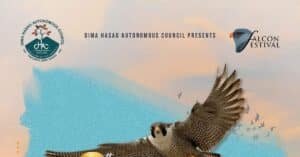The Amur Falcon, a true marvel of the avian world, embarks on an extraordinary journey spanning over 22,000 kilometers from its breeding grounds in Siberia to the distant shores of South Africa. Along this remarkable migration route, North East India emerges as a crucial and captivating stopover, where arrival of the raptor is celebrated as Amur Falcon Festival in many parts of North East India. Here, in this blog, you will read why the falcons rest in North East India, where do you find Amul Falcon in North East India and why Amur Falcon Festival is held.
Places Where Amul Falcon Rest in North East India
Amur Falcons find refuge in North East India during their migration journey. The Doyang river dam in Pangti village, situated in the scenic Wokha district of Nagaland, serves as a vital stopover for these birds. The Pangti village of Nagaland is the biggest roosting ground for Amur Falcon. In Manipur, the Tamenglong district hosts large flocks of these avian travelers, providing temporary shelter for a few weeks. Additionally, isolated roosting sites can be observed in Assam’s Dima Hasao district.
Time of Arrival of Amur Falcon in North East India
Renowned as the world’s longest-traveling raptor, the Amur Falcon embarks on an extraordinary journey from their breeding grounds in Siberia and northern China. En route to their final destination in Africa, they make a crucial stopover in North East India. Without fail, like clockwork, every year from mid-October to early November, these incredible birds grace the region with their presence, marking a spectacular moment in North East India. Sometimes, its stopover is extended by few days. So, one can spot Amur Falcon in North East India from mid-october to mid-november.
Why Amur Falcon Rest at North East India?
The Amur Falcons rest in North East India during their migration for several important reasons:
- Favorable Geography: North East India, with its diverse landscapes, provides a variety of habitats and roosting spots, making it an attractive stopover for migratory birds. This region’s wetlands, forests, and open areas offer suitable resting and foraging grounds for the falcons.
- Abundant Food: North East India is teeming with insects and small prey that the Amur Falcons rely on for sustenance during their journey. The availability of ample food sources makes it an ideal pit stop for these birds.
- Climate: The climate in this region during the falcon’s migration period is conducive for resting and refueling. The mild temperatures and relatively stable weather conditions provide the falcons with a comfortable environment for resting and preparing for the next leg of their long journey.
- Migration Strategy: The Amur Falcons have evolved to follow a route that includes North East India as part of their migratory path. This strategy allows them to rest and recover before crossing over the daunting Indian Ocean to reach their final destination in Africa.
What is Amur Falcon Festival?
The Amur Falcon Festival is celebrated with a clear objective in mind – to raise awareness about the protection and conservation of these remarkable avian travelers. Typically held in the first or second week of November, the festival serves as a powerful platform to strengthen the vital bond between humans and nature. Through this celebration, local communities and conservationists come together to educate people about the significance of preserving the Amur Falcon and its habitat. By showcasing the beauty and importance of these migratory birds, the festival aims to foster a sense of responsibility towards nature and inspire collective efforts to safeguard these magnificent creatures and the ecosystems they depend on.
Where Amur Falcon Festival is Celebrated?
Amur Falcon Festival is celebrated on the three main roosting grounds of North East India. The places where it is celebrated are:
Pangti village, Wokha district of Nagaland
The Doyang region witnesses the annual arrival of nearly one million Amur Falcons, making it one of the largest congregations of these exquisite birds. This extraordinary event spans a three-day festival and typically coincides with the post-harvest festival of the Lotha Nagas, known as Tokhu Emong. The festival features a diverse array of wildlife conservation activities, including awareness campaigns, wildlife film screenings, nature treks, cross-country races, bird-watching expeditions, and a nature photography contest. Among these festivals, the Amur Falcon Festival of Nagaland stands out as the most prominent and significant.
Tamenglong district, Manipur
The Amur Falcon Festival in Tamenglong district, located 150 km west of Imphal, is a significant event in the region. Since 2018, the state forest department has been actively involved in conducting regular checks and awareness programs, along with organizing joint patrolling initiatives in the district. These efforts underscore the commitment of the local authorities to safeguard the Amur Falcons and their habitats, making the festival a focal point for raising awareness and promoting conservation of these awe-inspiring birds.
Umrangso, Karbi Anglong District of Assam
The Falcon Festival in Umrangso is a vibrant two-day celebration, representing a new initiative by the Tourism and Wildlife Department in collaboration with the Wildlife Trust of India (WTI). This exciting event not only showcases the breathtaking presence of the Amur Falcons during their migration but also emphasizes the growing importance of wildlife conservation.
















